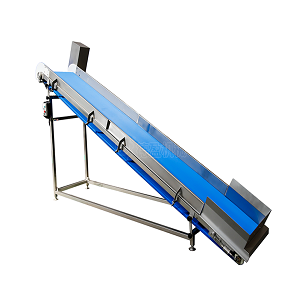Vegetable Conveyors are integral components of food processing lines, facilitating the movement of vegetables throughout the production process. Their applications in food processing are diverse and crucial for ensuring efficient, hygienic, and safe handling of vegetables.

| Technical Parameters: | |
| Overall dimensions: | 2860×850×1500mm |
| Voltage: | 380V |
| Power: | 0.37kW |
| Production: | 800-1000kg/h |
| Customization: | customizable |
Here's an overview of the applications of Vegetable conveyors in food processing:
Raw Vegetable Handling
Vegetable conveyors are used at the beginning of food processing lines to transport raw vegetables from receiving areas to the initial processing stations. They facilitate the continuous flow of vegetables, ensuring a steady supply for subsequent processing steps.
Washing and Cleaning
Vegetable conveyors play a vital role in conveying vegetables through washing and cleaning stations. They transport vegetables through water baths, brushes, and other cleaning mechanisms to remove dirt, debris, and surface contaminants, ensuring the cleanliness of the produce before further processing.
Sorting and Grading
Conveyors are employed in sorting and grading stations to segregate vegetables based on size, shape, color, and quality parameters. They transport vegetables past sensors, cameras, and manual inspection stations where sorting decisions are made, ensuring only high-quality produce moves forward in the processing line.
Cutting and Slicing
Vegetable conveyors transport pre-washed and sorted vegetables to cutting and slicing machines. They ensure a continuous supply of vegetables to these processing equipment, optimizing the efficiency of slicing, dicing, and chopping operations while maintaining uniformity in the final product.
Blanching and Cooking
In certain food processing applications, such as canning and frozen vegetable production, conveyors transport vegetables through blanching and cooking processes. They carry vegetables through steamers, blanching tanks, or cooking vessels at controlled temperatures and durations to achieve desired texture, flavor, and shelf life.
Drying and Dehydration
Conveyors transport blanched or cooked vegetables to drying and dehydration equipment. They facilitate the removal of excess moisture from the vegetables, either through air drying, vacuum drying, or freeze-drying processes, preparing them for packaging and preservation.
Packaging and Weighing
Vegetable conveyors transport dried or partially processed vegetables to packaging stations. They facilitate the filling of bags, pouches, trays, or containers with precise quantities of vegetables, often integrating with weighing and portioning systems to ensure accurate packaging.
Quality Control Inspections
Conveyors play a role in transporting vegetables through quality control checkpoints. They facilitate visual inspections, metal detection, and other quality control measures to identify and remove any defective or contaminated vegetables from the production line, ensuring product safety and compliance with standards.
Storage and Distribution
After processing and packaging, conveyors transport packaged vegetables to storage areas or distribution channels. They facilitate the movement of finished products to refrigerated storage facilities, warehouses, or shipping docks for further distribution to retailers or consumers.
Sanitation and Maintenance
Proper sanitation and maintenance of conveyors are essential to food safety and operational efficiency. Conveyor systems are designed for easy cleaning, with features such as removable belts, washdown components, and sanitary construction materials, reducing the risk of microbial contamination and ensuring compliance with food safety regulations.
In summary, vegetable conveyors play a critical role in the food processing industry by facilitating the efficient and hygienic handling of vegetables throughout the production process. From raw material handling to packaging and distribution, these conveyors optimize workflow, ensure product quality, and contribute to the overall efficiency and safety of food processing operations.




